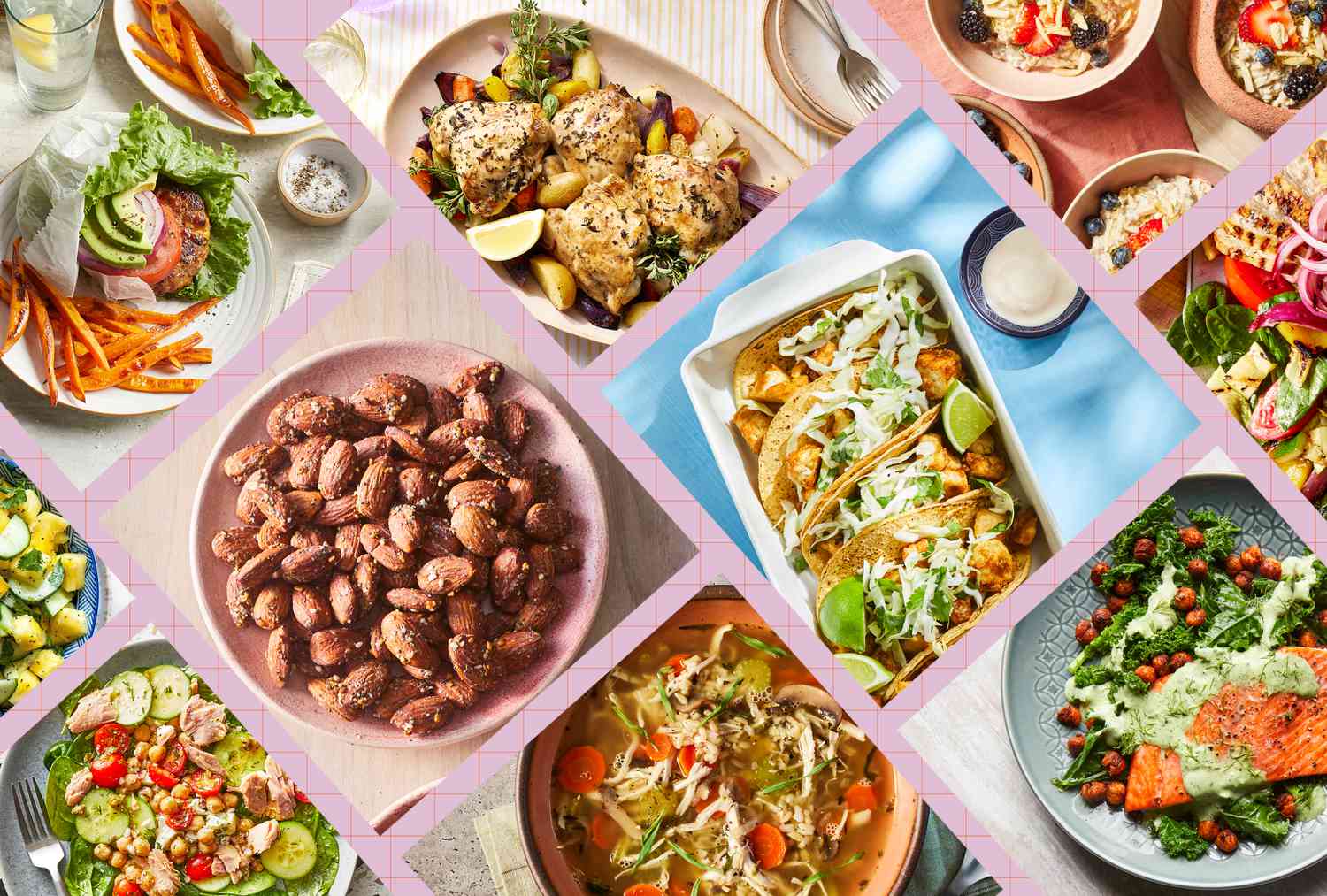If you have high blood pressure—also called hypertension—you’ve probably been told to limit your sodium intake. While it’s a good idea to watch your intake if your numbers are elevated, it’s not the only tool to lower blood pressure levels. Increasing exercise, incorporating more fruits, vegetables and potassium-rich foods, and de-stressing may all help as well. In this 7-day high-protein, no-sugar meal plan, we include plenty of whole foods that are high in potassium and protein and low in sodium with no added sugar to help improve your blood pressure.
High blood pressure is fairly common, impacting approximately 50% of adults in the United States. But just because it’s common doesn’t mean it shouldn’t be taken seriously. High blood pressure is often without symptoms but can wreak havoc on your health. Continued high blood pressure puts stress on the arteries, leading to heart damage and an increased risk of heart attack and stroke. Focusing on a heart-healthy eating pattern, staying active and staying in touch with your medical provider for regular blood pressure checks are all beneficial steps to protect your heart.
Why This Meal Plan Is Great for You
In this 7-day high-protein meal plan, each day provides at least 80 grams of protein while focusing on nutrients and foods that help support a healthy heart. To promote healthy blood pressure, we incorporate the principles of the DASH diet, which stands for Dietary Approaches to Stop Hypertension. This healthy eating pattern emphasizes a high intake of fruits, vegetables, whole grains, legumes and healthy fats like nuts, unsaturated oils and fish, while limiting fatty meats, processed foods and sugar-sweetened foods. Because most of us eat more added sugars than we realize and they provide few nutritional benefits, we opted to skip them in this plan. We do include plenty of natural sugars found in fruits, vegetables and unsweetened dairy—all of which are staples in the DASH diet.
Since weight loss may help reduce blood pressure, we set this meal plan to 1,500 calories, with modifications for 2,000 calories to support those with different calorie needs. While we previously included meal plans and modifications for 1,200 calories, we no longer do. The 2020-2025 Dietary Guidelines for Americans suggests that limiting your calories to 1,200 per day is too low for most people to meet their nutritional needs, plus it’s unsustainable for long-term health and well-being.
Though protein is the emphasis of this meal plan, we didn’t skimp on fiber. Each day provides at least 28 grams of this heart-healthy nutrient. Protein and fiber are two important nutrients for overall health, but also play an important role in weight loss because they help promote satiety and fullness. As with all meal plans, use this as a template for a healthy high-protein DASH eating plan but aim to eat to your hunger cues and make substitutions as desired.
Day 1
Breakfast (279 calories)
A.M. Snack (292 calories)
- 1 medium apple
- 2 Tbsp. natural peanut butter
Lunch (371 calories)
P.M. Snack (115 calories)
- ½ cup low-fat plain strained Greek-style yogurt
- ½ cup raspberries
Dinner (447 calories)
Daily Totals: 1,503 calories, 69g fat, 103g protein, 118g carbohydrate, 28g fiber, 1,507mg sodium
Make it 2,000 calories: Add 1 serving Pineapple Green Smoothie to breakfast and add ¼ cup unsalted dry-roasted almonds to P.M. snack.
Day 2
Photographer: Brie Goldman, Food Stylist: Addelyn Evans, Prop Stylist: Gabriel Greco
Breakfast (367 calories)
A.M. Snack (131 calories)
Lunch (348 calories)
P.M. Snack (163 calories)
- ½ cup low-fat plain strained Greek-style yogurt
- ½ cup raspberries
- 1 Tbsp. chopped nuts, such as walnuts
Dinner (484 calories)
Daily Totals: 1,493 calories, 54g fat, 92g protein, 171g carbohydrate, 32g fiber, 1,581mg sodium
Make it 2,000 calories: Add 1 slice sprouted-wheat toast with 1 Tbsp. natural peanut butter to breakfast, increase to 4 Tbsp. chopped nuts at P.M. snack and add 1 serving Apple with Cinnamon Almond Butter as an evening snack.
Day 3
Breakfast (375 calories)
A.M. Snack (140 calories)
- ½ cup no-salt-added low-fat cottage cheese
- 1 medium peach
Lunch (348 calories)
P.M. Snack (204 calories)
- ¼ cup unsalted dry-roasted almonds
Dinner (444 calories)
Daily Totals: 1,511 calories, 63g fat, 82g protein, 167g carbohydrate, 32g fiber, 1,320mg sodium
Make it 2,000 calories: Add 1 serving Pineapple Green Smoothie to P.M. snack and add 1 serving Apple with Cinnamon Almond Butter as an evening snack.
Day 4
Breakfast (367 calories)
A.M. Snack (131 calories)
Lunch (348 calories)
P.M. Snack (252 calories)
- 1 medium apple
- 1½ Tbsp. natural peanut butter
Dinner (416 calories)
Daily Totals: 1,514 calories, 57g fat, 85g protein, 175g carbohydrate, 33g fiber, 1,639mg sodium
Make it 2,000 calories: Add 1 slice sprouted-wheat toast with 1 Tbsp. natural peanut butter to breakfast, ¼ cup unsalted dry-roasted almonds to A.M. snack and 1 medium banana as an evening snack.
Day 5
Breakfast (375 calories)
A.M. Snack (220 calories)
- ¼ cup unsalted dry-roasted almonds
- 1 plum
Lunch (348 calories)
P.M. Snack (115 calories)
- ½ cup low-fat plain strained Greek-style yogurt
- ½ cup raspberries
Dinner (442 calories)
Meal-Prep Tip: Reserve 2 servings Chicken Parmesan Casserole to have for lunch on Days 6 and 7.
Daily Totals: 1,495 calories, 59g fat, 86g protein, 168g carbohydrate, 36g fiber, 1,278mg sodium
Make it 2,000 calories: Add 1 cup low-fat kefir to breakfast, add 1 serving Traditional Greek Salad to dinner and add 1 serving Apple with Cinnamon Almond Butter as an evening snack.
Day 6
Breakfast (375 calories)
A.M. Snack (140 calories)
- ½ cup no-salt-added low-fat cottage cheese
- 1 medium peach
Lunch (442 calories)
P.M. Snack (200 calories)
- 2 large hard-boiled eggs
- 1 medium orange
Dinner (357 calories)
Daily Totals: 1,514 calories, 62g fat, 88g protein, 159g carbohydrate, 33g fiber, 1,257mg sodium
Make it 2,000 calories: Add ¼ cup unsalted dry-roasted almonds to A.M. snack and add 1 medium banana with 1½ Tbsp. natural peanut butter as an evening snack.
Day 7
Breakfast (340 calories)
A.M. Snack (131 calories)
Lunch (442 calories)
P.M. Snack (140 calories)
- ½ cup no-salt-added low-fat cottage cheese
- 1 medium peach
Dinner (463 calories)
Daily Totals: 1,512 calories, 55g fat, 96g protein, 175g carbohydrate, 32g fiber, 1,489mg sodium
Make it 2,000 calories: Add 1 serving Pineapple Green Smoothie to breakfast and add ¼ cup unsalted dry-roasted almonds to A.M. snack.
How to Meal-Prep Your Week of Meals
- Make One-Pot Chicken & Rice Soup to have for lunch on Days 2 through 5.
- Prepare Everything-Seasoned Almonds to have as a snack throughout the week.
Frequently Asked Questions
-
Is it OK to mix and match meals if there is one I do not like?If there is a meal you don’t like, feel free to repeat a different meal on this list or check out some of our other healthy high-protein and no-sugar dinner recipes. If you’re following this plan for weight loss, you may want to choose a meal with a similar calorie, protein and fiber level or adjust a snack or two to meet your needs.
-
Can I eat the same breakfast or lunch every day?Yes, each breakfast and lunch recipe offers a very similar calorie range, so you can eat the same breakfast or lunch every day if that’s easier.
-
Why is there not a modification for 1,200 calories?We no longer provide modifications for 1,200-calorie days in our meal plans. The 2020-2025 Dietary Guidelines for Americans suggests that limiting calories to 1,200 per day is too low for most people to meet their nutritional needs, plus it’s unsustainable for long-term health and well-being.
Foods to Focus on to Lower Blood Pressure
- Fruits
- Vegetables
- Whole grains (oats, bulgur, whole wheat, freekeh, quinoa, buckwheat, whole-grain rice)
- Low-fat dairy (yogurt, kefir, cottage cheese)
- Beans and lentils
- Nuts and seeds, including natural nut butters
- Poultry
- Eggs
- Lean red meat
- Fish
- Olive oil
- Avocado
- Soy (including edamame and tofu)
- Herbs and spices
Can Protein Help Lower Blood Pressure?
Protein isn’t historically the focus of a healthy high blood pressure eating pattern, but research is showing that it may deserve more of our attention. A study on the food behaviors of over 12,000 Chinese adults and the onset of hypertension found that the adults who ate four or more different protein sources each week were 66% less likely to be diagnosed with high blood pressure compared to study participants who consumed two or fewer sources of protein each week. The study is a good reminder that our overall eating pattern is important for heart health. Eating a wide variety of DASH-friendly protein-rich foods, like fish, whole grains, poultry, legumes, nuts and low-fat dairy, focusing on nutrient-rich fruits and vegetables, cutting back on salt and cooking more meals at home are key pieces of the puzzle.
How We Create Meal Plans
Registered dietitians thoughtfully create EatingWell’s meal plans to be easy-to-follow and delicious. Each meal plan meets specific parameters depending on the health condition and/or lifestyle goal it is targeting and is analyzed for accuracy using the nutrition database, ESHA Food Processor. As nutritional needs differ from person to person, we encourage you to use these plans as inspiration and adjust as you see fit.


